Corporate Social Responsibility (CSR) Analysis and Report - MGT100
VerifiedAdded on 2023/01/20
|6
|1457
|98
Report
AI Summary
This report analyzes the concept of Corporate Social Responsibility (CSR) based on the article "The Truth About CSR" by Rangan, Chase, and Karim. The main argument of the article is that CSR should be a core organizational goal, supporting social and environmental activities alongside professional motivation. The report examines how companies implement CSR, categorizing activities into philanthropic, operational effectiveness, and business model transformation theatres. It discusses assumptions and limitations, such as the impact of CSR on revenue and costs, and the importance of coordination. The report highlights ideas for a united practice platform, including pruning programs, developing metrics, coordinating programs, and creating an interdisciplinary CSR strategy. A real-world example of Amazon's CSR initiatives is provided, illustrating how companies are engaging in CSR for profit. The report concludes by emphasizing the interrelation of CSR and management, and the importance of coordination and coherence in CSR activities.
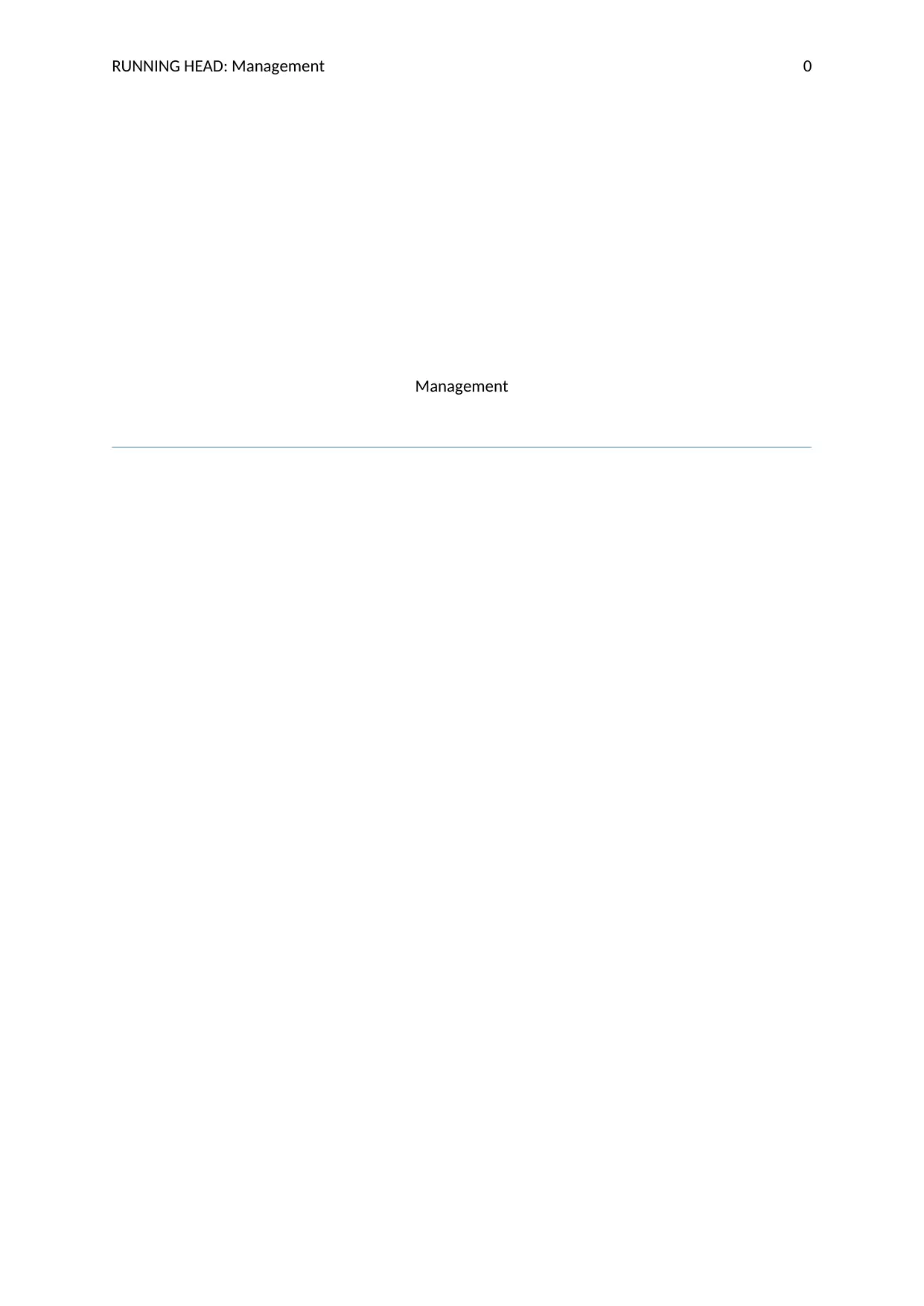
RUNNING HEAD: Management 0
Management
Management
Paraphrase This Document
Need a fresh take? Get an instant paraphrase of this document with our AI Paraphraser

Management 1
Contents
Main argument......................................................................................................................................2
Assumptions and limitations..................................................................................................................2
Conclusion of the article........................................................................................................................3
Ideas relevant to themes........................................................................................................................3
Example of real business.......................................................................................................................4
References.............................................................................................................................................5
Contents
Main argument......................................................................................................................................2
Assumptions and limitations..................................................................................................................2
Conclusion of the article........................................................................................................................3
Ideas relevant to themes........................................................................................................................3
Example of real business.......................................................................................................................4
References.............................................................................................................................................5
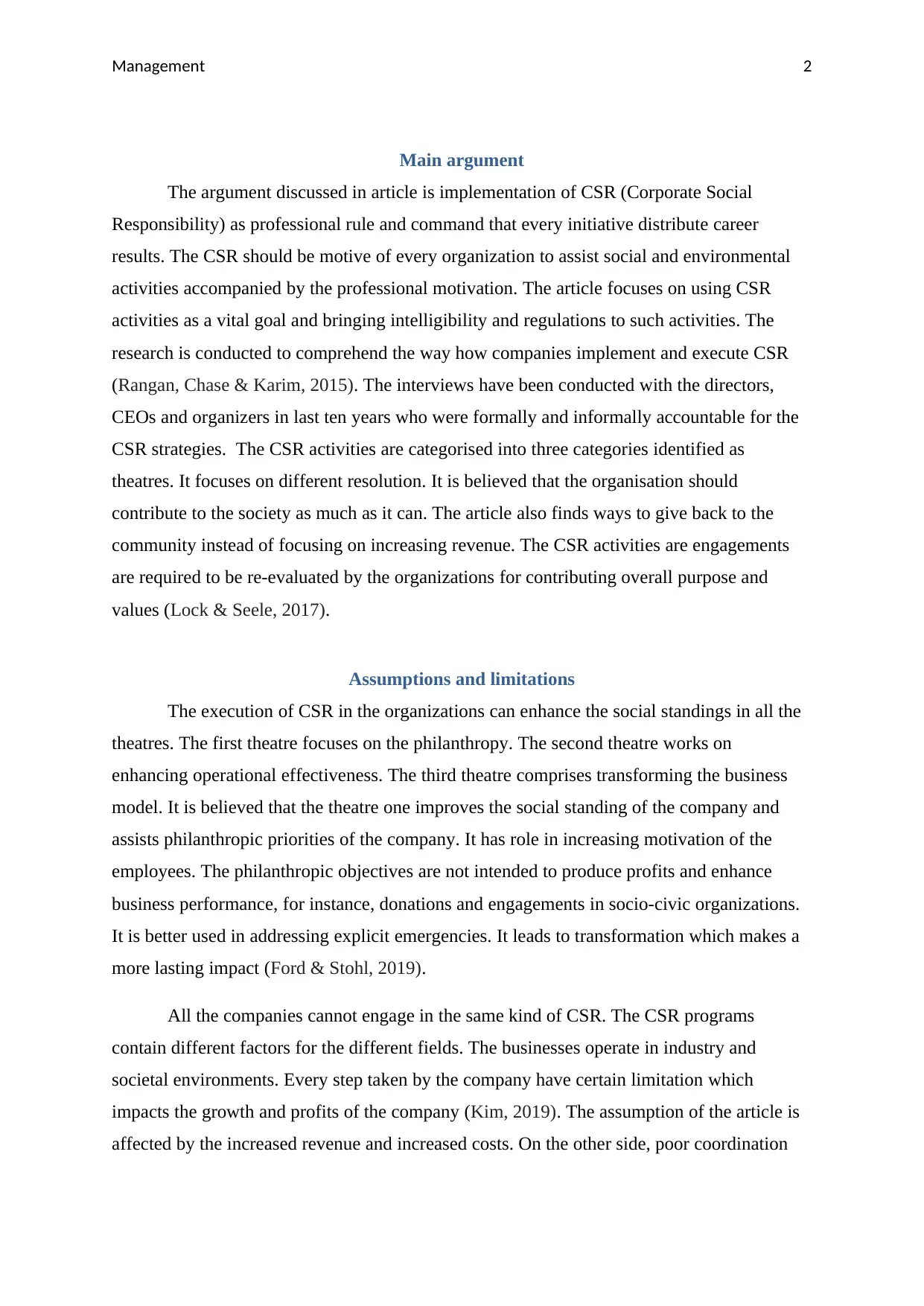
Management 2
Main argument
The argument discussed in article is implementation of CSR (Corporate Social
Responsibility) as professional rule and command that every initiative distribute career
results. The CSR should be motive of every organization to assist social and environmental
activities accompanied by the professional motivation. The article focuses on using CSR
activities as a vital goal and bringing intelligibility and regulations to such activities. The
research is conducted to comprehend the way how companies implement and execute CSR
(Rangan, Chase & Karim, 2015). The interviews have been conducted with the directors,
CEOs and organizers in last ten years who were formally and informally accountable for the
CSR strategies. The CSR activities are categorised into three categories identified as
theatres. It focuses on different resolution. It is believed that the organisation should
contribute to the society as much as it can. The article also finds ways to give back to the
community instead of focusing on increasing revenue. The CSR activities are engagements
are required to be re-evaluated by the organizations for contributing overall purpose and
values (Lock & Seele, 2017).
Assumptions and limitations
The execution of CSR in the organizations can enhance the social standings in all the
theatres. The first theatre focuses on the philanthropy. The second theatre works on
enhancing operational effectiveness. The third theatre comprises transforming the business
model. It is believed that the theatre one improves the social standing of the company and
assists philanthropic priorities of the company. It has role in increasing motivation of the
employees. The philanthropic objectives are not intended to produce profits and enhance
business performance, for instance, donations and engagements in socio-civic organizations.
It is better used in addressing explicit emergencies. It leads to transformation which makes a
more lasting impact (Ford & Stohl, 2019).
All the companies cannot engage in the same kind of CSR. The CSR programs
contain different factors for the different fields. The businesses operate in industry and
societal environments. Every step taken by the company have certain limitation which
impacts the growth and profits of the company (Kim, 2019). The assumption of the article is
affected by the increased revenue and increased costs. On the other side, poor coordination
Main argument
The argument discussed in article is implementation of CSR (Corporate Social
Responsibility) as professional rule and command that every initiative distribute career
results. The CSR should be motive of every organization to assist social and environmental
activities accompanied by the professional motivation. The article focuses on using CSR
activities as a vital goal and bringing intelligibility and regulations to such activities. The
research is conducted to comprehend the way how companies implement and execute CSR
(Rangan, Chase & Karim, 2015). The interviews have been conducted with the directors,
CEOs and organizers in last ten years who were formally and informally accountable for the
CSR strategies. The CSR activities are categorised into three categories identified as
theatres. It focuses on different resolution. It is believed that the organisation should
contribute to the society as much as it can. The article also finds ways to give back to the
community instead of focusing on increasing revenue. The CSR activities are engagements
are required to be re-evaluated by the organizations for contributing overall purpose and
values (Lock & Seele, 2017).
Assumptions and limitations
The execution of CSR in the organizations can enhance the social standings in all the
theatres. The first theatre focuses on the philanthropy. The second theatre works on
enhancing operational effectiveness. The third theatre comprises transforming the business
model. It is believed that the theatre one improves the social standing of the company and
assists philanthropic priorities of the company. It has role in increasing motivation of the
employees. The philanthropic objectives are not intended to produce profits and enhance
business performance, for instance, donations and engagements in socio-civic organizations.
It is better used in addressing explicit emergencies. It leads to transformation which makes a
more lasting impact (Ford & Stohl, 2019).
All the companies cannot engage in the same kind of CSR. The CSR programs
contain different factors for the different fields. The businesses operate in industry and
societal environments. Every step taken by the company have certain limitation which
impacts the growth and profits of the company (Kim, 2019). The assumption of the article is
affected by the increased revenue and increased costs. On the other side, poor coordination
⊘ This is a preview!⊘
Do you want full access?
Subscribe today to unlock all pages.

Trusted by 1+ million students worldwide
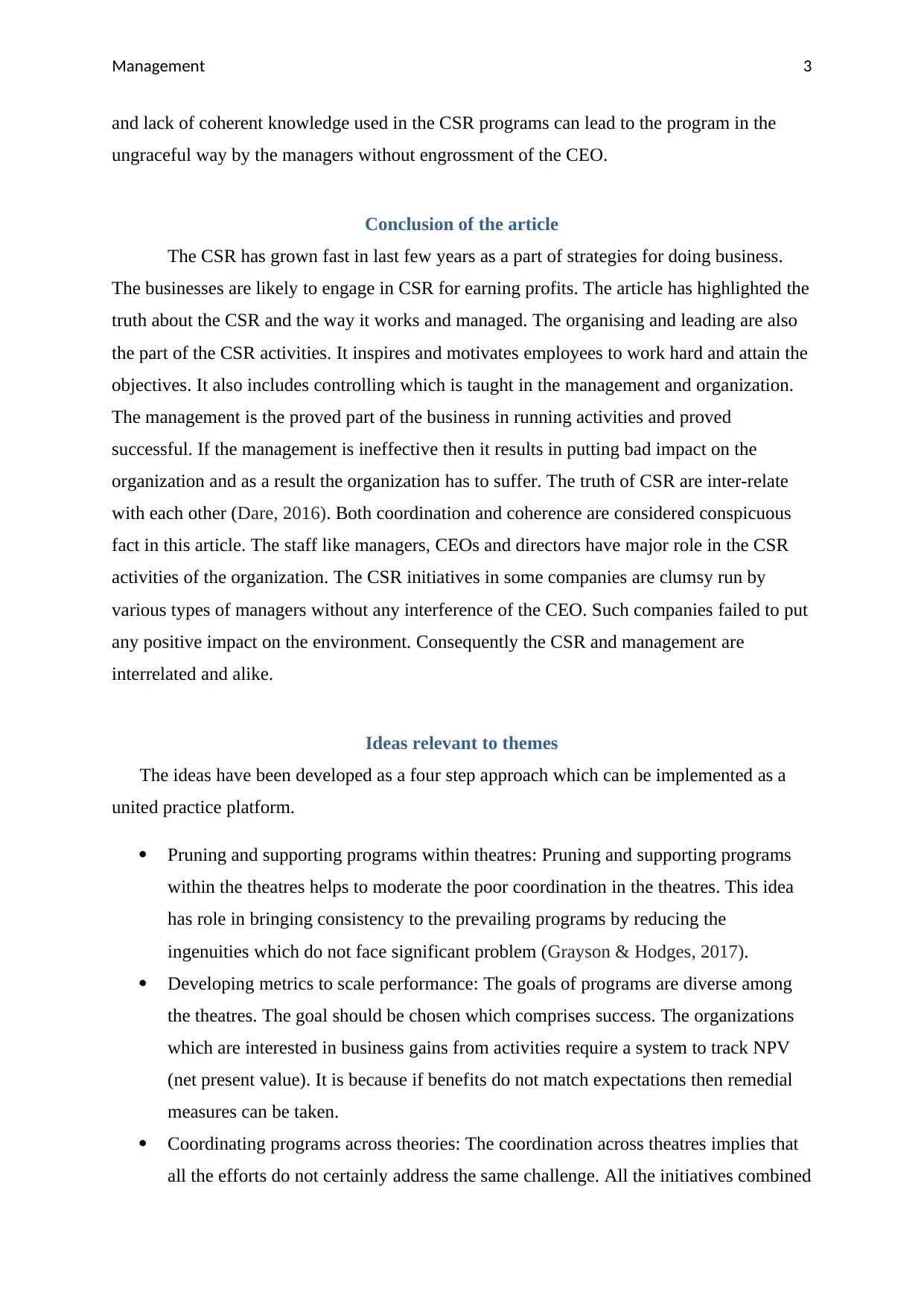
Management 3
and lack of coherent knowledge used in the CSR programs can lead to the program in the
ungraceful way by the managers without engrossment of the CEO.
Conclusion of the article
The CSR has grown fast in last few years as a part of strategies for doing business.
The businesses are likely to engage in CSR for earning profits. The article has highlighted the
truth about the CSR and the way it works and managed. The organising and leading are also
the part of the CSR activities. It inspires and motivates employees to work hard and attain the
objectives. It also includes controlling which is taught in the management and organization.
The management is the proved part of the business in running activities and proved
successful. If the management is ineffective then it results in putting bad impact on the
organization and as a result the organization has to suffer. The truth of CSR are inter-relate
with each other (Dare, 2016). Both coordination and coherence are considered conspicuous
fact in this article. The staff like managers, CEOs and directors have major role in the CSR
activities of the organization. The CSR initiatives in some companies are clumsy run by
various types of managers without any interference of the CEO. Such companies failed to put
any positive impact on the environment. Consequently the CSR and management are
interrelated and alike.
Ideas relevant to themes
The ideas have been developed as a four step approach which can be implemented as a
united practice platform.
Pruning and supporting programs within theatres: Pruning and supporting programs
within the theatres helps to moderate the poor coordination in the theatres. This idea
has role in bringing consistency to the prevailing programs by reducing the
ingenuities which do not face significant problem (Grayson & Hodges, 2017).
Developing metrics to scale performance: The goals of programs are diverse among
the theatres. The goal should be chosen which comprises success. The organizations
which are interested in business gains from activities require a system to track NPV
(net present value). It is because if benefits do not match expectations then remedial
measures can be taken.
Coordinating programs across theories: The coordination across theatres implies that
all the efforts do not certainly address the same challenge. All the initiatives combined
and lack of coherent knowledge used in the CSR programs can lead to the program in the
ungraceful way by the managers without engrossment of the CEO.
Conclusion of the article
The CSR has grown fast in last few years as a part of strategies for doing business.
The businesses are likely to engage in CSR for earning profits. The article has highlighted the
truth about the CSR and the way it works and managed. The organising and leading are also
the part of the CSR activities. It inspires and motivates employees to work hard and attain the
objectives. It also includes controlling which is taught in the management and organization.
The management is the proved part of the business in running activities and proved
successful. If the management is ineffective then it results in putting bad impact on the
organization and as a result the organization has to suffer. The truth of CSR are inter-relate
with each other (Dare, 2016). Both coordination and coherence are considered conspicuous
fact in this article. The staff like managers, CEOs and directors have major role in the CSR
activities of the organization. The CSR initiatives in some companies are clumsy run by
various types of managers without any interference of the CEO. Such companies failed to put
any positive impact on the environment. Consequently the CSR and management are
interrelated and alike.
Ideas relevant to themes
The ideas have been developed as a four step approach which can be implemented as a
united practice platform.
Pruning and supporting programs within theatres: Pruning and supporting programs
within the theatres helps to moderate the poor coordination in the theatres. This idea
has role in bringing consistency to the prevailing programs by reducing the
ingenuities which do not face significant problem (Grayson & Hodges, 2017).
Developing metrics to scale performance: The goals of programs are diverse among
the theatres. The goal should be chosen which comprises success. The organizations
which are interested in business gains from activities require a system to track NPV
(net present value). It is because if benefits do not match expectations then remedial
measures can be taken.
Coordinating programs across theories: The coordination across theatres implies that
all the efforts do not certainly address the same challenge. All the initiatives combined
Paraphrase This Document
Need a fresh take? Get an instant paraphrase of this document with our AI Paraphraser
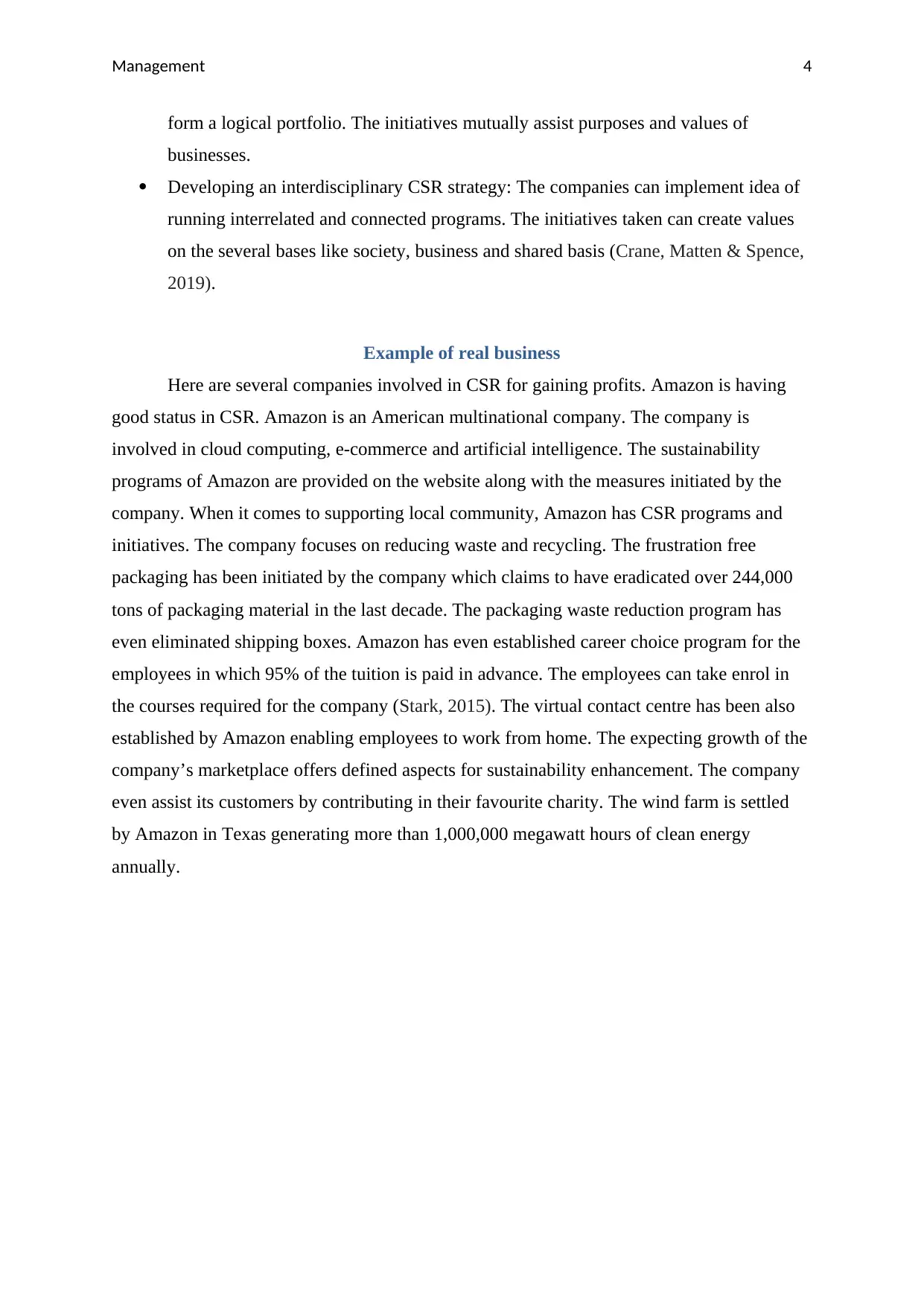
Management 4
form a logical portfolio. The initiatives mutually assist purposes and values of
businesses.
Developing an interdisciplinary CSR strategy: The companies can implement idea of
running interrelated and connected programs. The initiatives taken can create values
on the several bases like society, business and shared basis (Crane, Matten & Spence,
2019).
Example of real business
Here are several companies involved in CSR for gaining profits. Amazon is having
good status in CSR. Amazon is an American multinational company. The company is
involved in cloud computing, e-commerce and artificial intelligence. The sustainability
programs of Amazon are provided on the website along with the measures initiated by the
company. When it comes to supporting local community, Amazon has CSR programs and
initiatives. The company focuses on reducing waste and recycling. The frustration free
packaging has been initiated by the company which claims to have eradicated over 244,000
tons of packaging material in the last decade. The packaging waste reduction program has
even eliminated shipping boxes. Amazon has even established career choice program for the
employees in which 95% of the tuition is paid in advance. The employees can take enrol in
the courses required for the company (Stark, 2015). The virtual contact centre has been also
established by Amazon enabling employees to work from home. The expecting growth of the
company’s marketplace offers defined aspects for sustainability enhancement. The company
even assist its customers by contributing in their favourite charity. The wind farm is settled
by Amazon in Texas generating more than 1,000,000 megawatt hours of clean energy
annually.
form a logical portfolio. The initiatives mutually assist purposes and values of
businesses.
Developing an interdisciplinary CSR strategy: The companies can implement idea of
running interrelated and connected programs. The initiatives taken can create values
on the several bases like society, business and shared basis (Crane, Matten & Spence,
2019).
Example of real business
Here are several companies involved in CSR for gaining profits. Amazon is having
good status in CSR. Amazon is an American multinational company. The company is
involved in cloud computing, e-commerce and artificial intelligence. The sustainability
programs of Amazon are provided on the website along with the measures initiated by the
company. When it comes to supporting local community, Amazon has CSR programs and
initiatives. The company focuses on reducing waste and recycling. The frustration free
packaging has been initiated by the company which claims to have eradicated over 244,000
tons of packaging material in the last decade. The packaging waste reduction program has
even eliminated shipping boxes. Amazon has even established career choice program for the
employees in which 95% of the tuition is paid in advance. The employees can take enrol in
the courses required for the company (Stark, 2015). The virtual contact centre has been also
established by Amazon enabling employees to work from home. The expecting growth of the
company’s marketplace offers defined aspects for sustainability enhancement. The company
even assist its customers by contributing in their favourite charity. The wind farm is settled
by Amazon in Texas generating more than 1,000,000 megawatt hours of clean energy
annually.
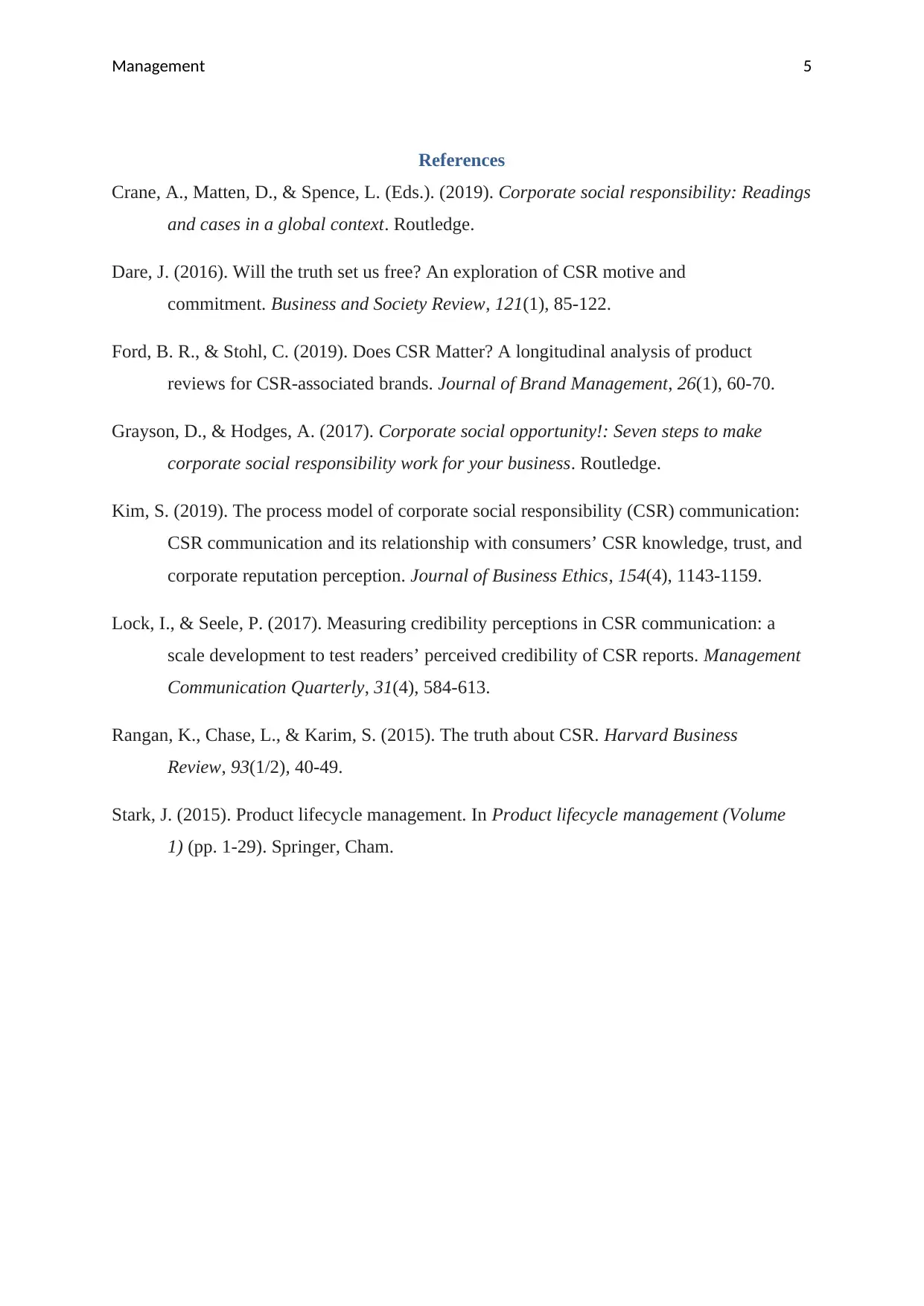
Management 5
References
Crane, A., Matten, D., & Spence, L. (Eds.). (2019). Corporate social responsibility: Readings
and cases in a global context. Routledge.
Dare, J. (2016). Will the truth set us free? An exploration of CSR motive and
commitment. Business and Society Review, 121(1), 85-122.
Ford, B. R., & Stohl, C. (2019). Does CSR Matter? A longitudinal analysis of product
reviews for CSR-associated brands. Journal of Brand Management, 26(1), 60-70.
Grayson, D., & Hodges, A. (2017). Corporate social opportunity!: Seven steps to make
corporate social responsibility work for your business. Routledge.
Kim, S. (2019). The process model of corporate social responsibility (CSR) communication:
CSR communication and its relationship with consumers’ CSR knowledge, trust, and
corporate reputation perception. Journal of Business Ethics, 154(4), 1143-1159.
Lock, I., & Seele, P. (2017). Measuring credibility perceptions in CSR communication: a
scale development to test readers’ perceived credibility of CSR reports. Management
Communication Quarterly, 31(4), 584-613.
Rangan, K., Chase, L., & Karim, S. (2015). The truth about CSR. Harvard Business
Review, 93(1/2), 40-49.
Stark, J. (2015). Product lifecycle management. In Product lifecycle management (Volume
1) (pp. 1-29). Springer, Cham.
References
Crane, A., Matten, D., & Spence, L. (Eds.). (2019). Corporate social responsibility: Readings
and cases in a global context. Routledge.
Dare, J. (2016). Will the truth set us free? An exploration of CSR motive and
commitment. Business and Society Review, 121(1), 85-122.
Ford, B. R., & Stohl, C. (2019). Does CSR Matter? A longitudinal analysis of product
reviews for CSR-associated brands. Journal of Brand Management, 26(1), 60-70.
Grayson, D., & Hodges, A. (2017). Corporate social opportunity!: Seven steps to make
corporate social responsibility work for your business. Routledge.
Kim, S. (2019). The process model of corporate social responsibility (CSR) communication:
CSR communication and its relationship with consumers’ CSR knowledge, trust, and
corporate reputation perception. Journal of Business Ethics, 154(4), 1143-1159.
Lock, I., & Seele, P. (2017). Measuring credibility perceptions in CSR communication: a
scale development to test readers’ perceived credibility of CSR reports. Management
Communication Quarterly, 31(4), 584-613.
Rangan, K., Chase, L., & Karim, S. (2015). The truth about CSR. Harvard Business
Review, 93(1/2), 40-49.
Stark, J. (2015). Product lifecycle management. In Product lifecycle management (Volume
1) (pp. 1-29). Springer, Cham.
⊘ This is a preview!⊘
Do you want full access?
Subscribe today to unlock all pages.

Trusted by 1+ million students worldwide
1 out of 6
Related Documents
Your All-in-One AI-Powered Toolkit for Academic Success.
+13062052269
info@desklib.com
Available 24*7 on WhatsApp / Email
![[object Object]](/_next/static/media/star-bottom.7253800d.svg)
Unlock your academic potential
Copyright © 2020–2025 A2Z Services. All Rights Reserved. Developed and managed by ZUCOL.





